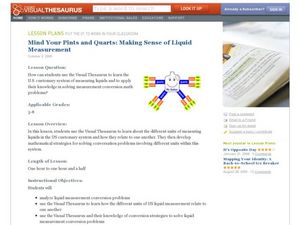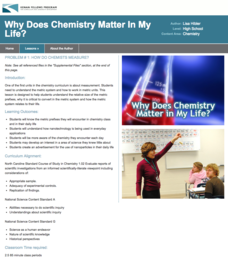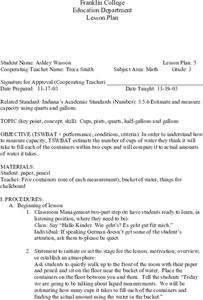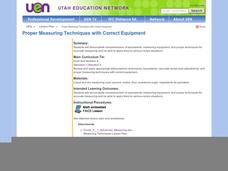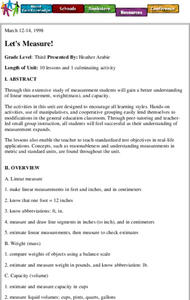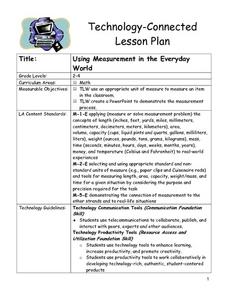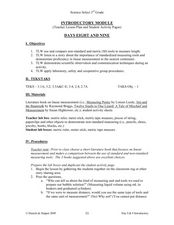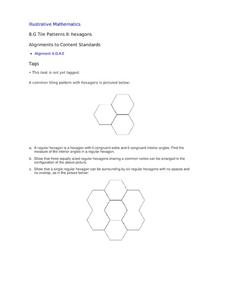Curated OER
Mind Your Pints and Quarts: Making Sense of Liquid Measurement
Elementary and middle schoolers identify different units of liquid measurement. They use the online Visual Thesaurus to learn about the relationships between units of liquid measurement.
Curated OER
Liquid Measurements
A clever visual known as "Measurement Man" is used to relate the number of units used to measure an object. Fourth graders fill in blanks with the correct numbers to show how many cups in a pint, how many quarts in a gallon, and other...
Curated OER
Mind Your Pints and Quarts: Making Sense of Liquid Measurement
Students convert among liquid measurement units. In this measurement lesson plan, students use Visual Thesaurus to gather information about customary units for liquid measure such as cup, pint, and quart, then students practice...
Kenan Fellows
How Do Chemists Measure?
Young chemists create gold nanoparticles as they learn to measure accurately with the metric system. They create an advertisement for the application of nanotechnology to complete the first lesson in a series of six.
Curated OER
Measure Up! Capacity Chart
Students experiment with various containers to explore standard units of liquid capacity. They create a diagram to illustrate the liquids and units of measurement that each container holds. Each student is then challenged to compute...
Curated OER
Liquid Measurement
Third graders investigate liquid measurements by estimating how many cups it takes to fill containers. The students predict the liquid measurements and then find the actual amount using the water in a bucket. Students then compare...
Curated OER
Proper Measuring Techniques with Correct Equipment
There is no better way to contextualize fractions than in a real-life situation. Learners demonstrate their ability to convert, measure, and determine fractional equivalents as they pertain to both liquid and dry measurements, as needed...
Curated OER
Back To the Basics: Measurement
Lead the class in a review of the basic concepts and procedures involved in measuring length, weight, and volume. After whole group instruction, small groups and individuals practice measuring by completing a variety of fun activities...
Discovery Education
Malachi's Medication
What's on a prescription medicine label? After learners practice measuring Malachi's prescribed dosage for his medication, they collaboratively discuss and explain why measuring it with the proper measuring tools is essential. Young...
Curated OER
Water: Liquid or Solid?
First graders investigate how water can be both a liquid and a solid. They weigh popsicles and observe them as they write in their science journals. They measure the liquid as the popsicle melts and refreeze them to change them back...
Institute of Electrical and Electronics Engineers
Try Your Hand at Nano
Fascinating reading about nanotechnology, nanoscale properties, and liquid crystals precedes a fun activity for young engineers. They measure their hands in nanometers, research, and then investigate how heat effects a sheet containing...
Curated OER
The Measurement Man
Learners explore the measurements of capacity by constructing a creative project in the shape of a man. The man has body parts that represent different units of measurement and can be used to make conversions. This is highly concrete and...
Curated OER
Shaking Up Ice Cream
Upper graders use a variety of tools to measure liquid and solid ingredients in an ice cream making recipe. Following written and oral directions and accurately timing themselves forms the basis of this lesson.
Curated OER
Mass Measurement
Middle schoolers explore geometry by completing a physics activity on-line. In this mass measurement activity, pupils define the terms mass, volume, and density and identify their relationship with each other. They complete an on-line...
Curated OER
Let's Measure
Third graders practice measuring different objects. They discover the concepts of ratio and proportion and practice converting numbers into the correct unit. They read stories as well to help them with the concepts.
Curated OER
Using Measurement in the Everyday World
Students use an appropriate unit of measure to measure an item in the classroom. They create a PowerPoint to demonstrate the measurement process. Pupils are divided into pairs. Students use a concept map to discuss the terms for...
Curated OER
Measuring Temperatures
Fourth graders participate in a teacher-led discussion about temperature--hot and cold. Each group of students is assigned specific materials for their lab experiment. They record temperatures measured in their journals and then plot...
Curated OER
Introductory Module
Third graders examine the non-standard method of measurement and compare it to the metric system of measurement. In this introductory module lesson, 3rd graders discover the scientific observation. Students also develop communication...
Curated OER
Three States of Matter
Third graders investigate the three states of matter and the properties of materials as they undergo physical changes. They identify examples of each type of matter, role-play atoms in solids, liquids, and gases, and conduct an...
Curated OER
Measure Object Using English and Metric Systems
Students are able to measure various objects using English and metric systems within half of the smallest unit of the measurement device. Students identify units of length, volume, mass and temperature according to International System...
Consortium for Ocean Science Exploration and Engagement (COSEE)
Ocean Acidification: Whats and Hows
Open this lesson by demonstrating the production of acidic carbon dioxide gas by activated yeast. Emerging ecologists then experiment with seashells to discover the effect of ocean acidification on shelled marine organisms. They measure...
Curated OER
Tile Patterns II: Hexagons
After learning that the sum of interior angles for triangles is 108 degrees, take it further to show that the sum of angles in any polygon is the same! Using hexagons, pupils practice finding the measure of the six congruent angles. Make...
LABScI
Cell Diffusion and Permeability: The See-Thru Egg Lab
Create a model to study a microscopic phenomenon. The seventh of 12 lessons uses an egg (without its shell) to represent a cell membrane. Using different solutions, learners explore the concept of cell diffusion. They monitor...
Institute of Electrical and Electronics Engineers
Keep it Cool
This cool lesson plan is ideal for elementary engineers or physical scientists, especially when learning about heat transfer and insulation. After reading a page of background information, engineering teams collaborate to design and...


